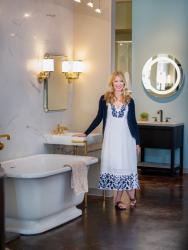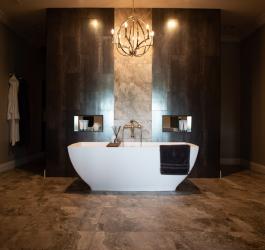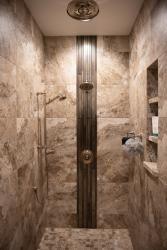SLHL: In recent years, bathrooms have evolved from being purely functional to zen-like getaways. What bathroom features do you believe make one bathroom more relaxing than another?
Betsy: Bathrooms should evoke feelings of calm, serenity and peace; not just after renovation, but every time you walk in. Put function first—no exceptions. A bathroom that functions well for you and your family is always relaxing and gratifying. Choosing fixtures that simplify your tasks is one way to accomplish this. For example, consider a single handle faucet over a traditional widespread; they can be used with one hand, they maximize counter space and they are easier to clean. Instead of installing a basic towel bar, consider upgrading to a heated towel bar—they offer both function and luxury all in one.
SLHL: What is the difference between a "wet-room" and the "open-room concept?"
Betsy: A wet room is where there are no walls or dividers to separate the shower and tub (sometimes this includes the vanity and toilet). Each element is exposed to one another. The entire bathroom floor is sloped, all walls are tiled and everything gets wet. This concept gained momentum in Japan where very small bathrooms are the norm. An open room concept (although this can be interpreted in different ways) is where the bedroom and bathroom are designed as one. For example, in a master bath application, there would be no door to the bathroom—the shower, tub and vanity are open and viewable from the bedroom area. Usually the toilet is enclosed in a water closet. Both of these concepts are fairly unique and require thoughtfulness on the homeowners’ end to determine if they’re right for them and their lifestyle.
SLHL: Several metal finishes seem to come in and out of popularity. Is there one metal finish that has stood the test of time? What metal finish are the top designers using in 2020?
Betsy: Polished chrome has always stood the test of time and will always be relevant in bathroom fixtures. On the other hand, designers and trendsetters right now are gravitating towards gold: anything gold—polished, brushed, unlacquered—and also matte black. Matte black is particularly interesting because we are noticing it starting to replace oil rubbed bronze as it fits so seamlessly into the popular modern farmhouse theme.
SLHL: Do vessel sinks require a particular style of faucet to help water from splattering?
Betsy: No. The vessel style itself is more important when trying to determine the “splash factor.” The goal is to find one that has some degree of slope (not a flat bottom) and has tall enough walls to contain the water while in use. The placement of the faucet is also important because all too often we see applications where the water lands directly on the drain which causes considerable splattering. If the faucet had been installed an inch closer or farther from the bowl, the water spray could avoid hitting the drain altogether.
SLHL: How do you feel about the new digital products showing up in the bathroom?
Betsy: Finally excited! Digital bathroom products have really evolved quickly over the past few years. They’re practical, less complicated and more intuitive for the average homeowner. Digital valving in the shower is a great option for anyone craving a serene, minimalist, spa-like look. Not only does the digital valve eliminate all the hardware once needed, it also allows the user more flexibility and control than a manual valve. As Millennials continue to grow and shape our marketplace, digital products will keep evolving and will continue to grow in popularity, and will hopefully become more mainstream as our trade communities adapt to embracing them, too.
SLHL: There are so many different styles of shower heads. How does one choose what is best for them?
Betsy: We get this question all the time. The issue is that the best showerhead for me may not be the best option for you. Showerheads are restricted to a maximum 2.5 gallons of water per minute. So whether you have a 12-inch overhead rainhead or a 3-inch diameter stationary showerhead, they’re technically pushing the same amount of water. The rainhead will have a wider, broader spray, but the showerhead will have a feeling of more pressure. Bigger isn’t always better in this scenario. Speak with your bathroom professional and let them guide you based on your personal needs and expectations. Try not to let online reviews and others’ opinions skew your decision.
SLHL: What is an essential element in bathroom design that many homeowners overlook?
Betsy: Storage. If you do not have designated areas to store your belongings, it causes unnecessary stress and clutter. It seems silly investing your money in luxurious new countertops to then have them loaded down and covered up with personal hygiene products for all to see. In my field, medicine cabinets are not only overlooked but underestimated. If you need a mirror anyway, why not have hidden storage behind it? Medicine cabinets now offer integral lighting, built-in electrical outlets, magnifying mirrors and even music. They can be recessed and framed to look just like a regular mirror. A true blend of beauty and practicality—the formula for a relaxing bathroom!









